When choosing between traditional grills and flat tops for your food truck, consider your menu, space, and efficiency needs. Traditional grills deliver smoky flavor and appealing char marks, perfect for burgers and steaks, but may require more maintenance and space. Flat tops cook evenly and quickly, ideal for breakfast, stir-fries, and versatile dishes, with less cleanup. To find the best fit for your operation and menu, keep exploring the key differences and benefits.
Key Takeaways
- Flat tops are more compact, easier to clean, and require less maintenance compared to traditional grills.
- Traditional grills produce smoky flavors and distinctive grill marks, ideal for charred, bold-tasting foods.
- Flat tops offer even heat distribution, supporting versatile menu items like stir-fries, sandwiches, and breakfast dishes.
- Flat tops generally have higher initial costs but provide better long-term durability and operational efficiency.
- Traditional grills often need more space and maintenance but excel at delivering smoky, high-heat searing.
Understanding the Basic Design and Functionality

To understand how traditional grills and flat tops differ, it’s important to first grasp their basic design and functionality. Traditional grills feature grates that elevate food above heat sources, creating grill marks and allowing fats to drip away. They often have a rugged, classic look that appeals to customers who value authentic barbecue aesthetics. Flat tops, on the other hand, are smooth, heated metal surfaces that provide even heat distribution across a large, flat area. Their sleek, modern appearance can attract a different customer base, emphasizing efficiency and versatility. Additionally, cooking surface types influence not just cooking style but also how customers perceive your food truck’s overall look and feel. The ease of cleaning and maintenance of each surface can significantly impact daily operations, making it an important consideration for food truck owners. Moreover, heat distribution plays a crucial role in achieving consistent cooking results across different surfaces. The cooking surface material can also affect durability and long-term performance, influencing your investment decision. Your choice depends on the type of food you want to serve and the aesthetic you want to project. Both designs influence not just cooking style but also how customers perceive your food truck’s overall look and feel. The selection of the cooking surface can also impact the ease of cleaning and maintenance, which are important factors for food truck operations.
Flavor Profile and Cooking Results

The flavor profile and cooking results of traditional grills and flat tops differ considerably due to their design. With a traditional grill, you get a smoky aroma that enhances the depth of flavors, thanks to open flames and charred surfaces. This method promotes crust development, giving meats and vegetables a desirable sear that adds texture and richness. Flat tops, on the other hand, produce a more uniform cook with less smoke infusion, resulting in milder flavors. They excel at creating consistent textures, especially for dishes requiring even heat. While traditional grills deliver bold, smoky tastes with distinct grill marks, flat tops focus on smooth, tender results. Your choice ultimately influences the flavor profile and the type of crust or caramelization you can achieve during cooking. Additionally, tuning options for different cooking appliances can optimize heat distribution and performance based on your preferred method. Incorporating cooking surface design considerations can further enhance your culinary outcomes by matching equipment features to your desired flavor and texture profiles. Recognizing the heat transfer method used in each type of equipment can help you better control cooking times and results. Understanding the thermal mass of your cooking surface can also impact heat retention and consistency during operation. Moreover, selecting the appropriate temperature control features allows for more precise adjustments, improving overall cooking efficiency.
Versatility of Menu Options
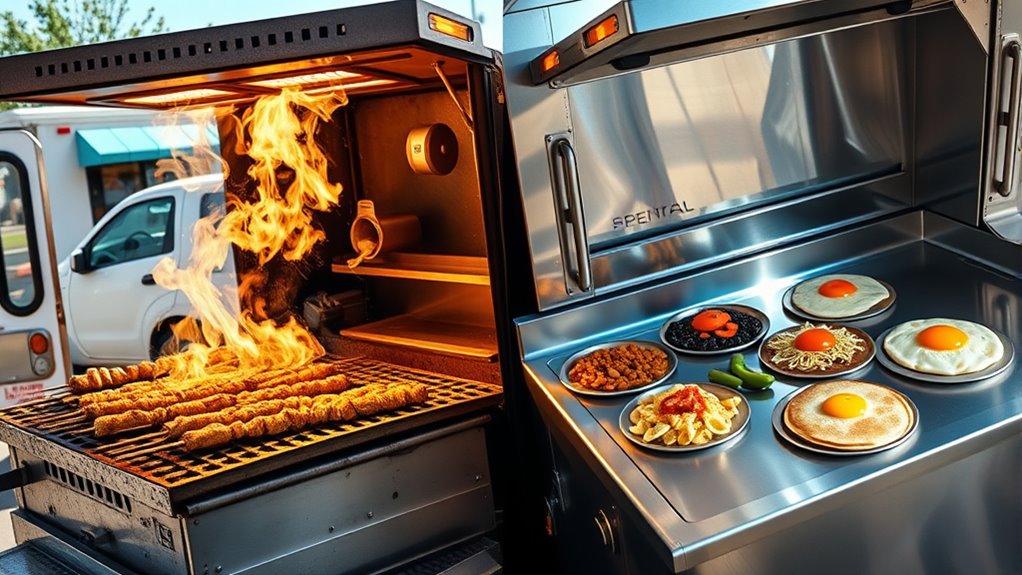
Traditional grills often limit you to foods that benefit from smoky flavors and high-heat searing, such as steaks, burgers, and vegetables. While great for those items, they can restrict your ability to diversify your menu options. Flat tops, on the other hand, provide a versatile cooking surface that allows you to easily incorporate ingredient pairing for a wide range of dishes, from breakfast items to stir-fries and sandwiches. This flexibility helps you meet customer preferences for variety and caters to different dietary needs. With a flat top, you can serve a broader menu without needing multiple cooking stations, making it easier to adapt to changing trends and customer demands. This versatility ultimately enhances your food truck’s appeal and helps you stand out.
Cooking Speed and Efficiency

Flat tops heat up quickly and maintain consistent temperatures, allowing you to cook multiple items simultaneously without long wait times. This consistent grill temperature makes it easier to manage your cooking process and speeds up service. With flat tops, you can use efficient cooking techniques like searing, sautéing, and quick stir-frying, which save you time and keep food hot and ready to serve. Unlike traditional grills, which might require adjusting heat zones or turning food to ensure even cooking, flat tops provide a uniform cooking surface that streamlines your workflow. This means you spend less time waiting for the grill to reach the right temperature and more time preparing and serving food. Overall, flat tops boost your efficiency by enabling faster, more controlled cooking. Understanding industry trends helps you stay competitive and adapt your equipment choices for maximum productivity. Additionally, arcade machines demonstrate how optimized technology can improve performance and user experience in various settings. Upgrading your cooking equipment to flat tops can also enhance your kitchen’s overall efficiency, leading to better customer satisfaction and increased throughput. Incorporating performance upgrades like flat tops can significantly impact your food truck’s operational success and customer satisfaction.
Maintenance and Cleaning Requirements
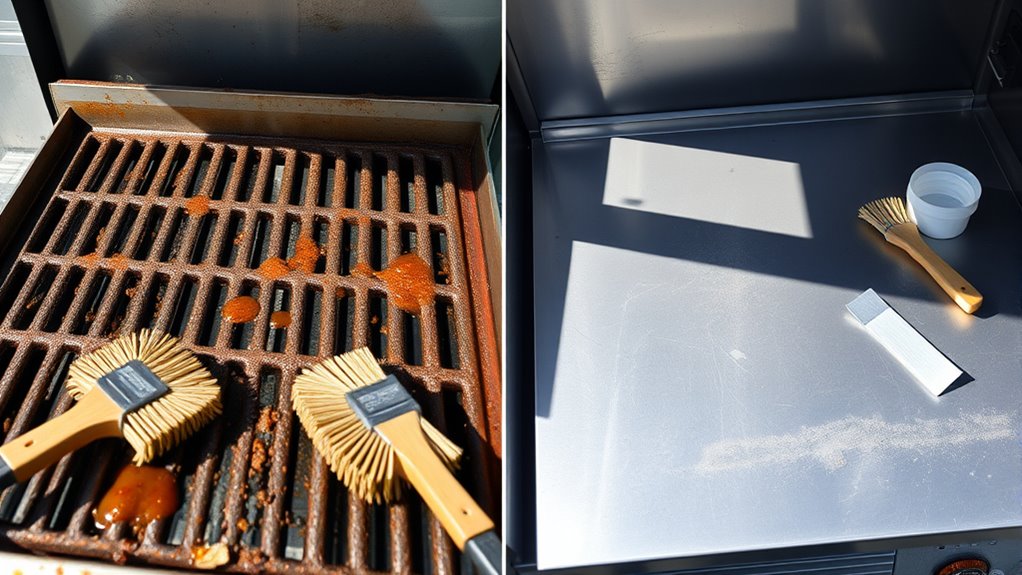
Maintaining and cleaning grills effectively can substantially impact their longevity and performance. When comparing traditional grills and flat tops, consider cleaning ease, which varies between them. Flat tops typically have smooth surfaces that are easier to wipe down and require less effort to keep clean, reducing maintenance time. Traditional grills, with grates and crevices, often demand more frequent cleaning to prevent buildup and ensure proper operation. Regular cleaning also helps prevent bacterial growth and ensures food safety standards are met. Proper cleaning of equipment is also important for equipment longevity and food safety. Additionally, understanding the GMC tuning process can help in maintaining engine efficiency and vehicle performance, similar to how regular grill maintenance preserves food preparation quality. By keeping up with these routines, you’ll extend your equipment’s life, maintain food quality, and minimize unexpected repairs.
Space and Portability Considerations
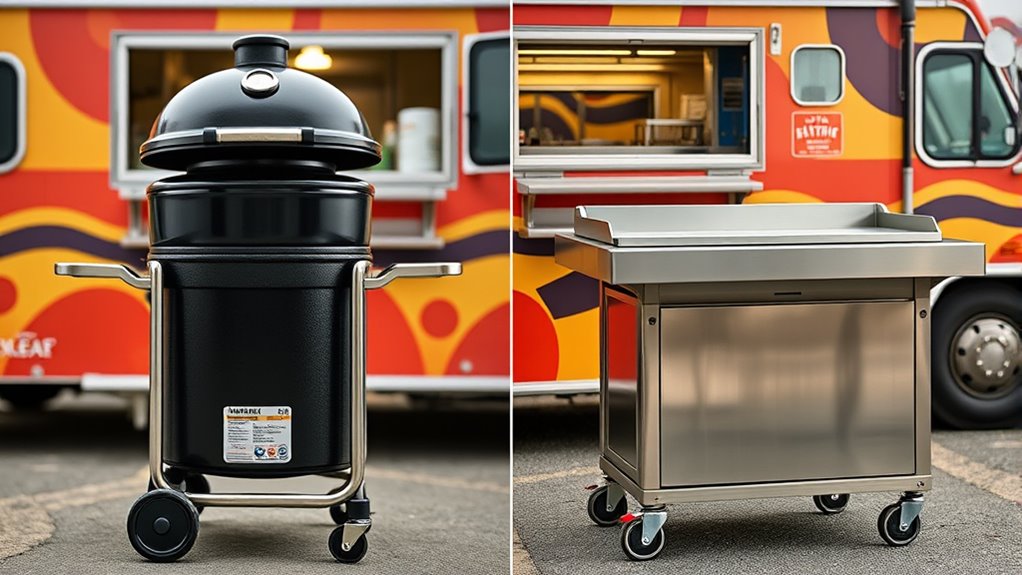
When choosing between a traditional grill and a flat top, considering space and portability is key. Think about the size and footprint to guarantee it fits comfortably in your outdoor area, and whether you’ll need to move it around easily. Also, evaluate how simple it is to transport and store your grill or flat top when not in use.
Size and Footprint
Choosing the right grill often depends on available space and portability needs. If your truck has limited space, a compact grill is essential. Traditional grills tend to have a larger footprint, which can limit workspace, but they often provide better control of grill temperature and smoke flavor. Flat tops usually have a smaller footprint, making them easier to fit into tight spaces, though they might lack some of the smoke flavor that traditional grills offer. Consider how much room you need for food prep and cooking. A larger grill can handle more food at once but might be harder to transport. Balance your space constraints with your desired cooking style, ensuring your setup supports efficient operation and the flavor profile your customers expect. Additionally, understanding residency requirements and legal procedures can help in planning your business setup effectively. Being aware of cost considerations can also influence your choice between these options to stay within budget while meeting your operational needs. Moreover, evaluating maintenance and durability of each grill type can impact long-term functionality and ease of use.
Mobility and Transport
Considering the space available and how easily you can move your grill makes a big difference in selecting the right setup. Traditional grills often require more room for setup and transport, especially if they have large legs or bulky accessories. Flat tops tend to be more streamlined, making them easier to load into a truck or storage area. When planning for mobility, think about how grill accessories and cooking techniques will impact portability—some accessories add weight or bulk, complicating transport. You’ll want a setup that allows quick disassembly or folding, so you can move efficiently between locations. Additionally, considering co-parenting strategies can help optimize your setup for quick and efficient relocations. Ultimately, choosing a grill that balances space, ease of transport, and your cooking needs will keep your food truck flexible and ready for any location.
Storage and Setup
Effective storage and setup are crucial for keeping your food truck organized and efficient. When choosing between a traditional grill and a flat top, consider how much space they require and how easily they can be transported and stored. Flat tops tend to be more compact, fitting into tighter spaces and simplifying setup. Traditional grills, especially larger models, might need more room for safe operation and storage. Think about how you’ll maintain proper grill temperature; a stable setup ensures consistent heat and smoke flavor. Portable options with efficient storage reduce setup time and help keep your workspace tidy. Additionally, understanding the role of automation in business can help streamline your operations and improve efficiency. Incorporating space-saving designs into your equipment choices can further optimize your truck’s layout and workflow.
Cost Implications and Investment Value
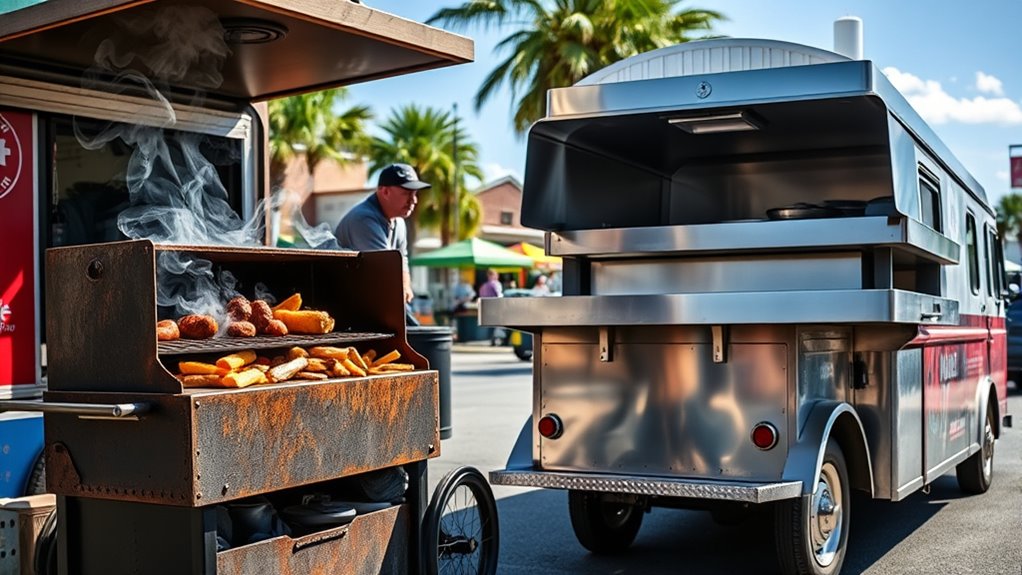
While traditional grills often have a lower initial purchase price, flat tops can represent a more substantial investment upfront, primarily due to their larger size and specialized construction. The initial investment for a flat top is higher, but it can offer better operational costs over time. Flat tops typically cook more efficiently, reducing fuel consumption and enabling you to prepare multiple items simultaneously. This efficiency can lower your overall operational costs, making them more cost-effective in the long run. Conversely, traditional grills may seem cheaper initially but might require more frequent replacements or maintenance, increasing expenses over time. When evaluating cost implications, consider both the upfront investment and ongoing operational costs to determine which option provides better value for your food truck.
Durability and Longevity in a Food Truck Environment
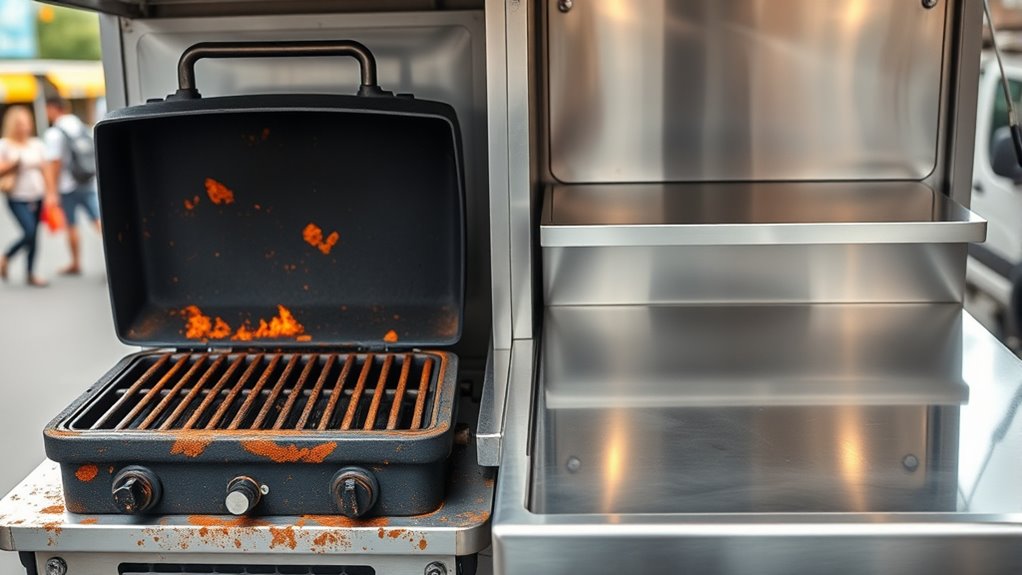
Durability and longevity are essential factors when choosing between traditional grills and flat tops for a food truck. You need equipment that withstands daily rigors, resisting wear and corrosion. Flat tops often feature thick, high-quality materials with superior material strength, enhancing their robustness. Traditional grills, made from stainless steel or cast iron, offer good corrosion resistance but may wear faster with constant use. Here’s how they compare:
| Feature | Traditional Grill | Flat Top |
|---|---|---|
| Material Strength | Moderate | High |
| Corrosion Resistance | Good | Excellent |
| Wear Resistance | Moderate | Superior |
| Maintenance Needs | Frequent | Less Frequent |
| Longevity | 3-5 years | 7+ years |
Ideal Menu Items for Each Cooking Method
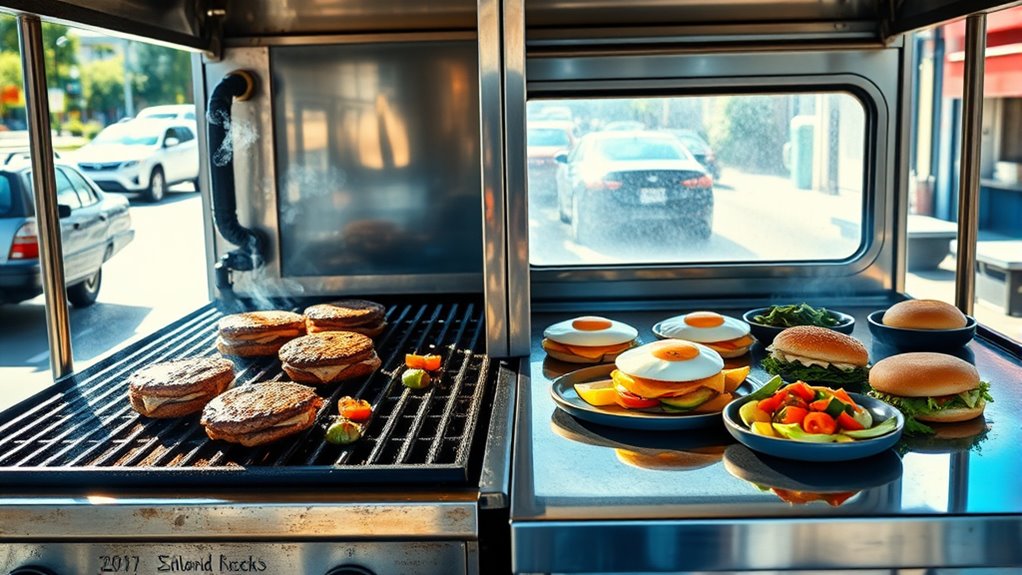
Choosing the right cooking method directly influences the menu items you can successfully serve. With a traditional grill, you excel at smoky, charred flavors, making it ideal for burgers, steaks, and skewers. You can offer a variety of grill toppings like grilled vegetables, cheese, and bacon to enhance flavors. Flat tops, on the other hand, excel at quick, evenly cooked foods like breakfast sandwiches, stir-fries, and hash bowls. You can customize these dishes with flat top sauces for added flavor. The flat top’s large surface area allows you to cook multiple ingredients simultaneously, making it perfect for combo meals. Understanding these differences helps you craft a menu that leverages each cooking method’s strengths, ensuring you serve delicious, top-quality food that appeals to your customers.
Frequently Asked Questions
Which Grill Type Is More Energy-Efficient for Food Trucks?
When considering energy consumption and fuel efficiency, you’ll find that flat tops often use less energy than traditional grills. They distribute heat evenly, reducing cooking time and fuel use. Flat tops heat up quickly and maintain consistent temperatures, which helps lower overall energy consumption. This means you can cook more efficiently, save on fuel costs, and operate your food truck more sustainably by choosing a flat top over a traditional grill.
How Do Weather Conditions Impact Each Grill’s Performance?
Imagine your grill battling a storm—irony strikes as weather resilience becomes essential. Weather conditions, with temperature fluctuations and wind, directly impact each grill’s performance. Traditional grills, exposed to the elements, may struggle with wind and rain, reducing efficiency. Flat tops, being more enclosed, offer better weather resilience, maintaining consistent heat. So, when weather turns nasty, your equipment’s ability to adapt makes all the difference in serving hot, tasty food.
Are There Health and Safety Concerns Specific to Each Grill Type?
You should consider health and safety concerns related to each grill type. Regular grill cleaning is essential to prevent grease buildup, which can cause flare-ups and smoke emissions. Traditional grills may produce more smoke emissions, raising concerns about air quality and ventilation. Flat tops generally generate less smoke, but you still need to make certain of proper cleaning and maintenance to prevent food contamination and ensure safe cooking conditions for your food truck operations.
Can Both Grills Be Customized for Branding Purposes?
You can definitely customize both grills for branding purposes. Many options exist to enhance branding, such as adding logos, colored panels, or custom paint. Both traditional grills and flat tops offer customization flexibility, allowing you to choose branding options that match your food truck’s theme. This way, you can create a visually appealing setup that attracts customers and promotes your brand effectively.
Which Grill Type Offers Better Resale Value After Years of Use?
Did you know that flat tops tend to hold their resale value better over time? You’re likely to get more for a flat top after years of use because of its long-term durability and easy maintenance. Traditional grills, while versatile, often face quicker wear and tear, decreasing their resale value. So, if resale value matters most, a flat top might be your smarter investment for long-term durability.
Conclusion
Choosing between a traditional grill and a flat top is like deciding between a classic novel and a modern story—both have their charm. Your decision shapes your menu, speed, and success on the road. Think of it as forging your culinary destiny, where each tool writes a different chapter. Whichever you choose, remember that your passion and skill will turn your food truck into a legendary tale worth telling.









